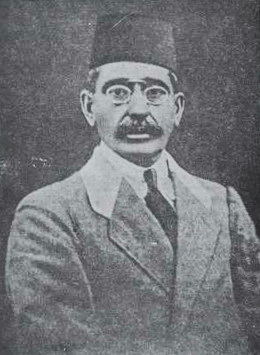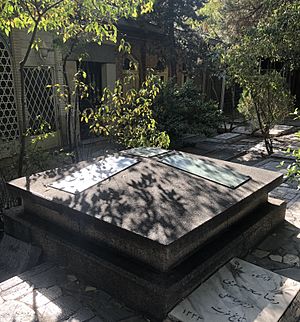Iraj Mirza facts for kids
Quick facts for kids
Iraj Mirza
|
|
|---|---|
 |
|
| Born | October 1874 Tabriz, Persia |
| Died | 14 March 1926 (aged 51) Tehran, Persia |
| Resting place | Zahir-od-dowleh cemetery |
| Occupation | Writer, poet |
| Alma mater | Tabriz Dar ul-Funun |
| Children | 3 |
| Relatives | Fath-Ali Shah Qajar (great-grandfather) |
Prince Iraj Mirza (Persian: ایرج میرزا, meaning Prince Iraj) was a famous Iranian poet. He was born in October 1874 and passed away on March 14, 1926, at age 51. He was known for his modern poems that often criticized old traditions. Iraj Mirza also translated books from French into Persian.
Early Life and Education

Iraj Mirza was born in October 1874 in Tabriz, a city in northwestern Iran. He came from a royal family. His great-grandfather was Fath-Ali Shah Qajar, who was the second king of the Qajar dynasty in Iran. Iraj's father, Gholam-Hossein Mirza, was also a poet for the royal court.
Iraj's father worked for Mozaffar al-Din Mirza, who was the Crown Prince at that time. Crown Princes during the Qajar era traditionally lived in Tabriz.
While some say Iraj was taught at home, he actually studied at a school called Dārolfonoon in Tabriz. By the age of 15, he was very good at Persian, French, Arabic, and Azerbaijani. He was also skilled in calligraphy, which is the art of beautiful handwriting. His handwriting was so artistic that he is still considered one of Iran's famous calligraphers.
Career and Life Changes
In 1890, when Iraj was 16, he got married. Sadly, when he was 19, both his father and his wife passed away.
After his father's death, Iraj took over his role as the court-poet for Mozaffar al-Din Mirza. When Mozaffar al-Din Mirza became king in 1896, Iraj was given the special title "Head of Poets." He was also known as Jalāl ol-Mamālek.
A few years later, Iraj left the royal court. He started working for Ali Khan Amin al-Dowleh, who was the governor of Iranian Azarbaijan. During this time, Iraj became even better at French and also learned some Russian.
In 1905, Iraj moved to Tehran with Amin al-Dowleh. He soon became involved in the Persian Constitutional Revolution. This was a big movement that aimed to bring more freedom and a constitution to Iran. In 1907, Iraj traveled to Europe with a government official named Ahmad Ghavam.
Two years later, Iraj returned to Tehran. He began working in a government office that handled official documents. In 1917, he joined the new Ministry of Culture. Three years later, he moved to the Ministry of Finance. From 1920 to 1925, he worked as a tax officer in Mashhad, a major city in northeastern Iran.
At 51, Iraj moved back to Tehran. He sadly passed away from a heart attack on March 14, 1926. He was survived by his second son, Khosrow Iraj.
His Amazing Poems
Iraj Mirza is known as one of Iran's most important modern poets. He was the first Iranian poet to use everyday language in his verses. This made his poems easy to understand and relatable. He added many common words and phrases to poetic language. His simple style is also famous for its cleverness and satire, which means using humor to criticize things.
During the Qajar era, Iraj was greatly influenced by the Persian Constitutional Revolution. This big change in the country shaped his unique poetry style. He mixed new ideas from Europe with his own thoughts. He often criticized the social problems in Iran. People admired how original he was in using comparisons to talk about these issues.
His poems are full of clever comparisons. He used sharp, witty words to point out dishonest religious leaders, business people, and politicians. Besides these everyday poems, Iraj also wrote special poems called elegies to praise important people of his time. He also wrote beautiful poems about raising children, a mother's love, and romance.
Iraj was a forward-thinking and creative poet. He was open to European ideas. Even though he was very skilled, he sometimes used similar rhymes. Some experts think he did this on purpose to challenge strict traditional poetry rules. He was a pioneer in new Persian poetry, but he never completely abandoned the rules of classical poetry.
Some of Iraj's most famous poems include "Satan," "Mother," "A Letter to a Poet Aref Ghazvini" (called Arefnameh), "Woman's Picture," "Story of the Veil or Hijab," and "The Story of Zohreh and Manouchehr." "The Story of Zohreh and Manouchehr" is based on William Shakespeare's poem "Venus and Adonis."
In his poem "Mother," Iraj beautifully describes a child's love for their mother. He shows how a mother cares for her child from birth. The words he uses are very touching and lovely, even when translated from Persian.
"The Story of Zohreh and Manouchehr" is another well-known work. In this poem, Iraj tells a story inspired by the Greek myth of Venus and Adonis. Zohreh, a goddess, comes to Earth and is charmed by Manouchehr. He doesn't return her feelings, and she eventually goes back to the gods. In 2004, a movie based on this story was released in France.
Iraj believed that the situation for Iranian women during his time was very difficult. He felt sad to see how hard life was for the brave women of Iran. This is why he wrote powerful and memorable poems about women's daily lives.
Tomb
Iraj Mirza's tomb is located in the Zahir-od-dowleh cemetery. This cemetery is in Shemiran, north of Tehran, between Darband and Tajrish.
Works
- Poems Divan
- Masnavi of Zohre o Manuchehr (not finished)
- Masnavi of Arefnameh
- Iraj Literary Works
- Romeo and Juliet (Translation from French)
See also
 In Spanish: Irach Mirzá para niños
In Spanish: Irach Mirzá para niños


